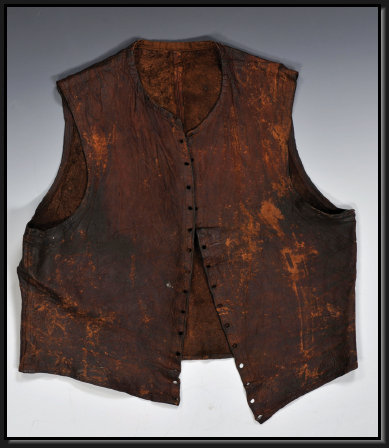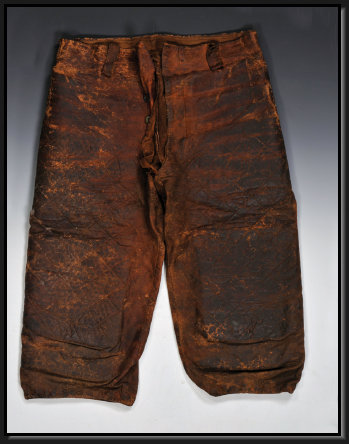
Chris Hornung
May 3, 2016
Page 2
May 3, 2016
Page 2
Questions or comments? Please email me at:







References
Gribble, Andrew. "How Greg Pruitt Made the Tear-away Jersey Famous And, Ultimately, a Forgotten Relic of Past." News RSS. www.clevelandbrowns.com, 26 Mar. 2015. Web. 23 Apr. 2016.
Sapardanis, Steve. "Anthony Carter and the Tear-Away Jersey | Storytime with Dr. Sap." MVictors.com. N.p., 08 Apr. 2015. Web. 23 Apr. 2016.
"Football - Queer Devices Worn by Players." The Rockland County Times [Haverstraw, NY] 17 Nov. 1894: Print.
"Lard and turpentine once the essentials." The Ottowa Citizen [Ottowa, Ontario] 15 Nov. 1962: Print.
"History." Harvard University. N.p., n.d. Web. 15 Aug. 2015. <http://www.harvard.edu/history>.
Camp, Walter. "Football." Boston: Houghton, Mifflin, 1896. Print.
Camp, Walter. "Football of '93." The Outing XXV (1894): 56-61. Web. 15 Aug. 2015.
Stagg, A. A. "Touchdown!" New York: Longmans, Green & Co, 1927. Print
"Football in Armour." The Strand Magazine [London, England] 1897: Print
Sapardanis, Steve. "Anthony Carter and the Tear-Away Jersey | Storytime with Dr. Sap." MVictors.com. N.p., 08 Apr. 2015. Web. 23 Apr. 2016.
"Football - Queer Devices Worn by Players." The Rockland County Times [Haverstraw, NY] 17 Nov. 1894: Print.
"Lard and turpentine once the essentials." The Ottowa Citizen [Ottowa, Ontario] 15 Nov. 1962: Print.
"History." Harvard University. N.p., n.d. Web. 15 Aug. 2015. <http://www.harvard.edu/history>.
Camp, Walter. "Football." Boston: Houghton, Mifflin, 1896. Print.
Camp, Walter. "Football of '93." The Outing XXV (1894): 56-61. Web. 15 Aug. 2015.
Stagg, A. A. "Touchdown!" New York: Longmans, Green & Co, 1927. Print
"Football in Armour." The Strand Magazine [London, England] 1897: Print
The football uniform of 1876 consisted of "a common long-sleeved jersey, an ordinary pair of long trousers, heavy walking shoes, and a skull cap [Rockland]." As in rugby, players could only tackle above the waist, and it was common for a player to grab and pull his opponent's jersey to assist in the tackle. Tired of repairing and replacing torn jerseys, Ledru P. Smock, a Princeton freshman who desired to become university's three-quarter back, "concluded to find some remedy for the evil."
Smock designed a canvas jacket that fit snug to his body and laced up his back, requiring a friend's assistance to "suit up." Drawing jeers and laughs from the other students, Smock took the field.
Smock designed a canvas jacket that fit snug to his body and laced up his back, requiring a friend's assistance to "suit up." Drawing jeers and laughs from the other students, Smock took the field.
#2 on our list is a uniform that would be more at home at a biker bar than the football field, the leather suit.
On November 25, 1893, two undefeated football titans, Harvard and Yale, met in New Haven, CT for one of the most anticipated games of the season. Yale came into the game with a 37 game winning streak, having outscored its 1893 opponents 324 to 6. Harvard boasted an even better margin of victory, 362-5, in their then undefeated 1893 campaign. When the Crimson took the field, their opponents and spectators were shocked by their distinct attire. Each man donned slick, tight-fitting, yellow leather suits. Compared to the canvas and moleskin uniforms of the day, the leather suits were lighter, water resistant, practically impossible to grasp. In his "Football of '93"article for the October 1894 edition of The Outing periodical, Walter Camp described the moment the suits were unveiled:
On November 25, 1893, two undefeated football titans, Harvard and Yale, met in New Haven, CT for one of the most anticipated games of the season. Yale came into the game with a 37 game winning streak, having outscored its 1893 opponents 324 to 6. Harvard boasted an even better margin of victory, 362-5, in their then undefeated 1893 campaign. When the Crimson took the field, their opponents and spectators were shocked by their distinct attire. Each man donned slick, tight-fitting, yellow leather suits. Compared to the canvas and moleskin uniforms of the day, the leather suits were lighter, water resistant, practically impossible to grasp. In his "Football of '93"article for the October 1894 edition of The Outing periodical, Walter Camp described the moment the suits were unveiled:
"....the moment he got the ball he dashed right in among his opponents. Tackling in those times was high, and, of course, sundry wild grabs were made for Smock's neck and shoulders. But he slipped through the grasp of everyone. Several players lost their finger nails in their efforts to stop the wearer of the improvised canvas jacket. As the game progressed it dawned upon the players that Smock had invented something worth thinking about, and it was only a few weeks aferward that home-made canvas jackets were worn by several players [Rockland]."
On April 28, 1877, Princeton faced played the Harvard Crimson in Cambridge, NY. Harvard protested when the Princeton eleven appeared wearing "Smocks." The canvas jackets gave Princeton an advantage, but the Tigers took it a step further. The players...
"...showed up buttered all over with lard, 'and in the game they greatly astonished the conservative New Haven by the way their runners slipped through the latters' fingers. Only by filling their hands with sand could tacklers retard the rushes."
Despite the protest and Princeton's unfair advantage, Harvard played the game and defeated Princeton 1-0. The following year, teams attempted to neutralize Princeton's lubricants by applying sticky resins and Venetian turpentine to their hands [Camp]. By 1878, nearly every major college football team had adopted some variation of Smock's jacket, which remained as standard equipment on the football field until around 1910. However, the Intercollegiate Football Association did put a stop to the use of applied substances in the early 1880's:
Rule 23: - No sticky or greasy substance shall be used on the person of players.
Intercollegiate Football Rules for 1883


While the lard jacket was outlawed shortly after it was introduced, the use of applied substances along with the tight fitting Smock jacket had an indelible impact on the evolution of football. Arm tackles and pulling the ball carrier to the ground became obsolete and proper tackling techniques and disciplined defensive alignments became cornerstones of great American football teams.
Leather football vest and pants, Legendary Auctions, 2013
“For a moment there was a hush, and then such shouts went up from the Harvard side as one hears at no other place than at these great football matches, while there was a gray blankness over-spreading the faces of the Yale supporters as they looked at these suits and thought how hard it would be to secure a satisfactory grasp of the wearers. Among the spectators upon the Yale side there were anxious looks and inquiries, and among the coaches there was a premonition of trouble. I suppose that it is natural for a man who feels that his friends are in trouble to go quickly to render assistance. This was remarkable at once among the Yale coaches, for almost every betrayed a wish to “get in and play against those suits.” I think this shows really how hard they were hit and how good they thought the suits. Such a device can never be kept entirely secret and there were two or three of the coaches who had been told before leaving the uptown quarters that Harvard would wear leather suits; for all that they were prepared for something quite different from these slippery, shining uniforms that gave the team a most martial appearance.”
Despite their uniform advantage, Harvard fell victim to Frank Butterworth's second half touch-down and lost the game 6-0. Other teams adopted the leather suit in subsequent years, but it ultimately failed to catch on for two reasons, cost and pride. According to "Football in Armour," an 1897 article published in Strand Magazine [Vol xiii],
Ivy League schools dominated late nineteenth century American football, and were the only programs in the country with revenues sufficient to support such an expense from their healthy athletic department budgets. So if they could afford leather suits, why did they stop using them? The true reason for the leather suits demise was most likely the Ivy League's gentlemanly ethos and the preservation of bragging rights. While never officially make illegal, the leather suit provided a team with an unequal advantage, potentially leading to the claim that it was the equipment and not the men who won the day. Enthusiastic supporters may have desired victory at all costs, but no player wanted to be accused that he hadn't earned it.
But a suit of leather is expensive, and, in spite of its lightness and its advantages in rainy weather, it was this expense that prevented its general adoption by the colleges of the United States.
Outlawed: Banned Uniforms of American Football
1886 Harvard Football Team swearing Smock jackets
With each new football season, new innovations are sure to play a part in the continued evolution of the game. As teams seek new ways to outsmart their opponents, one thing is certain, we haven't seen the last of uniforms banned from American football.
Epilogue
More Articles from AntiqueFootball

